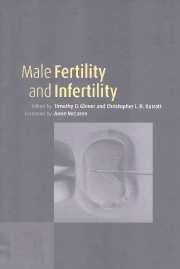Book contents
- Frontmatter
- Contents
- List of contributors
- Foreword by Anne McLaren, FRS
- Preface
- Acknowledgements
- Part 1 Biological perspectives
- 1 The evolution of the sexual arena
- 2 The role of sperm competition in reproduction
- 3 Sperm production and delivery in mammals, including man
- 4 The local control of spermatogenesis
- 5 Some misconceptions of the human epididymis
- 6 Transport of spermatozoa to the egg and fertilization success
- 7 Changes in human male reproductive health
- Part 2 Implications of the new technologies
- Index
5 - Some misconceptions of the human epididymis
from Part 1 - Biological perspectives
Published online by Cambridge University Press: 09 August 2009
- Frontmatter
- Contents
- List of contributors
- Foreword by Anne McLaren, FRS
- Preface
- Acknowledgements
- Part 1 Biological perspectives
- 1 The evolution of the sexual arena
- 2 The role of sperm competition in reproduction
- 3 Sperm production and delivery in mammals, including man
- 4 The local control of spermatogenesis
- 5 Some misconceptions of the human epididymis
- 6 Transport of spermatozoa to the egg and fertilization success
- 7 Changes in human male reproductive health
- Part 2 Implications of the new technologies
- Index
Summary
Introduction
The mammalian epididymis is part of the system of male accessory sex glands whose secretions constitute ejaculated seminal plasma (Mann & Lutwack-Mann, 1981). Unlike the other accessory glands, however, the epididymis is intimately involved with the development of spermatozoa from the moment they leave the testis to the point when they are ejaculated and deposited in the female tract. The basis for this statement is the large number of investigations carried out over many years on a wide variety of species, beginning with the pioneering experimental studies of Young (1929, 1931) on guinea pigs, which have enabled some basic principles to be established (Cooper, 1986; Orgebin-Crist, 1987). The molecular details of precisely how an infertile testicular spermatozoon is transformed into a fully fertile one in the epididymis are only slowly being unravelled and it is still not possible to pin-point any particular process or molecular component and say unequivocally that this is the crucial difference between fertility and infertility. The factors involved are almost certainly complex and interactive but there are enough experimental data to indicate that they exist and that the epididymis has an important regulatory role to play.
Despite the evidence alluded to above, and described in more detail below, a notion has arisen in recent years that in man the epididymis is relatively non-functional.
- Type
- Chapter
- Information
- Male Fertility and Infertility , pp. 85 - 104Publisher: Cambridge University PressPrint publication year: 1999



